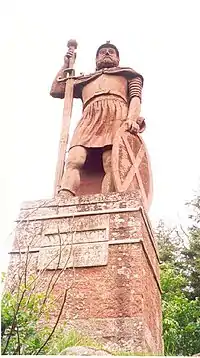Dryburgh
Dryburgh is a village in the Borders region of Scotland, within the county of Berwickshire. It is most famous for the ruined Dryburgh Abbey.

Dryburgh Abbey
Dryburgh Abbey was founded in the 12th century, and burned by English troops in 1322, and again in 1385. It was restored in the 15th century, before being destroyed in 1544. The ruined site is now a scheduled monument, and its grounds are listed in the Inventory of Gardens and Designed Landscapes in Scotland.
The Temple of the Muses
Nov2007.jpg.webp)
This circular nine columned gazebo stands since 1817 on Bass Hill, a mound overlooking the River Tweed at the west end of the village. It is dedicated to the poet James Thomson, the Ednam poet and author of "The Seasons" and the lyrics of Rule Britannia, and his bust can be seen on the top of the structure.
The temple originally contained a stone statue of the Apollo Belvedere on a circular pedestal showing nine Muses with laurel wreaths. Bronze figures of the Four Seasons by Siobhan O'Hehir were installed as a replacement in 2002.
William Wallace statue

Dryburgh was the first town to erect a monument in honour of William Wallace, in 1814. It is said that Sir Walter Scott did not like the structure. The current statue is in the grounds of Bemersyde House.
External links
| Wikimedia Commons has media related to Dryburgh. |
- Engraving of Dryburgh in 1693 by John Slezer at National Library of Scotland
